University Report: Diabetes and Health of Aboriginal Australians
VerifiedAdded on 2022/11/01
|17
|3899
|359
Report
AI Summary
This report investigates the prevalence and impact of diabetes within the Aboriginal Australian population. It begins with an executive summary and table of contents, followed by an introduction highlighting the disproportionate burden of diabetes among Aboriginal Australians compared to non-Aboriginals, along with associated health issues like high blood pressure. The core of the report is a literature review, synthesizing findings from multiple studies. These studies explore various aspects of diabetes in this community, including risk factors like age, lifestyle, and socioeconomic status; health outcomes such as kidney issues, severe pain, and fever; and the influence of factors like smoking and delayed treatment. The report concludes by summarizing the key findings from the literature review, emphasizing the need for further research into factors contributing to the rise of diabetes and the importance of tailored interventions to improve health outcomes. An abstract and a list of references complete the report.
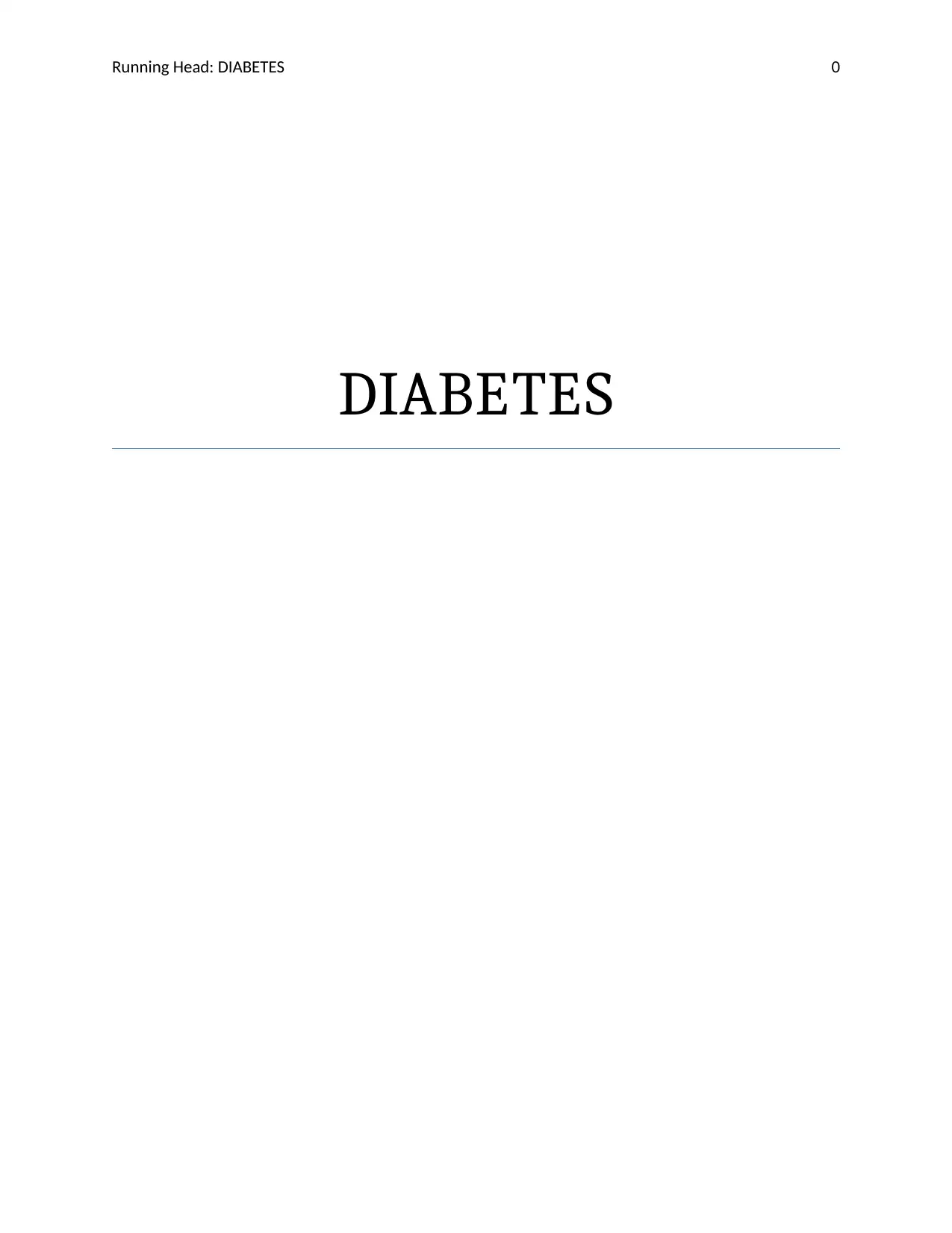
Running Head: DIABETES 0
DIABETES
DIABETES
Paraphrase This Document
Need a fresh take? Get an instant paraphrase of this document with our AI Paraphraser
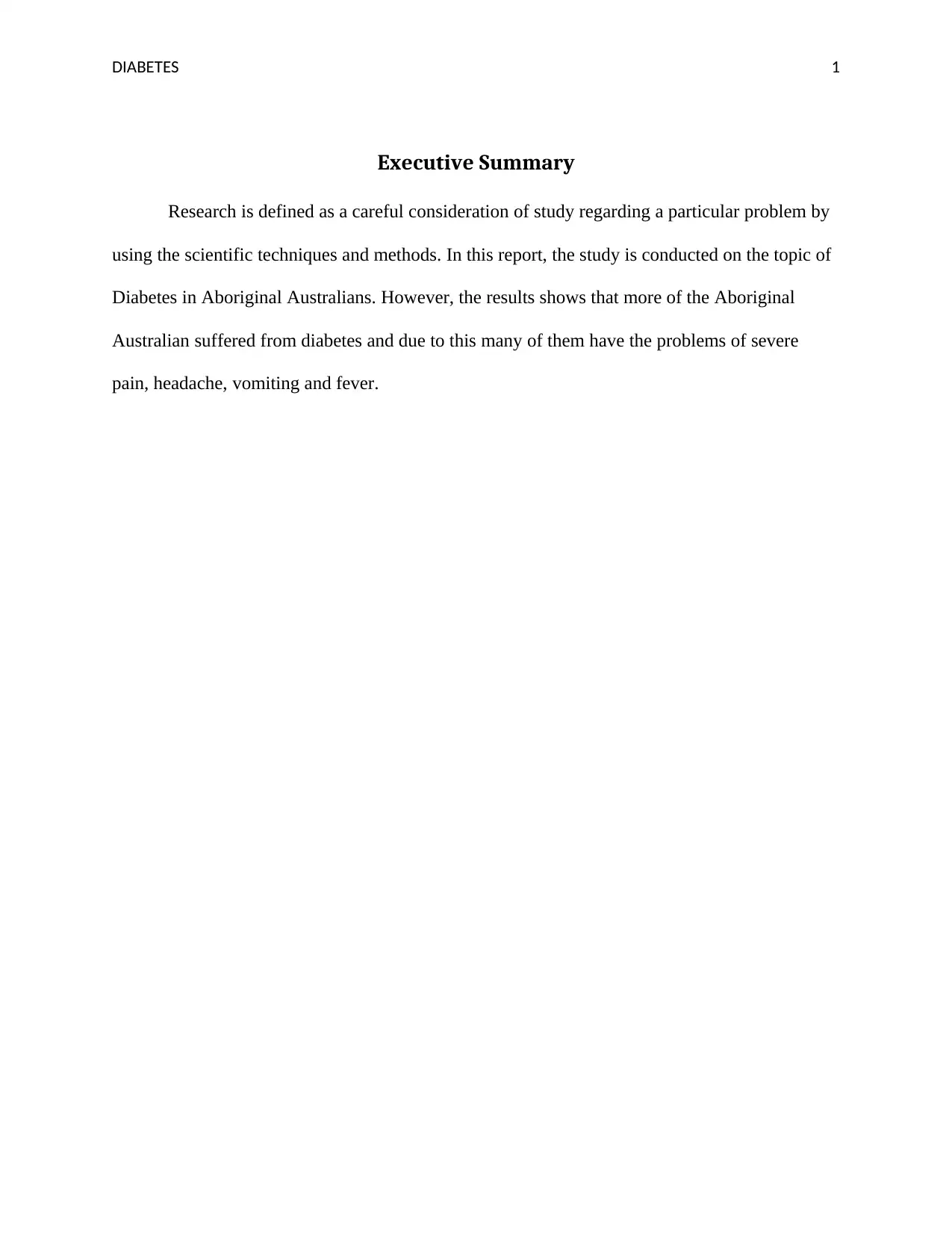
DIABETES 1
Executive Summary
Research is defined as a careful consideration of study regarding a particular problem by
using the scientific techniques and methods. In this report, the study is conducted on the topic of
Diabetes in Aboriginal Australians. However, the results shows that more of the Aboriginal
Australian suffered from diabetes and due to this many of them have the problems of severe
pain, headache, vomiting and fever.
Executive Summary
Research is defined as a careful consideration of study regarding a particular problem by
using the scientific techniques and methods. In this report, the study is conducted on the topic of
Diabetes in Aboriginal Australians. However, the results shows that more of the Aboriginal
Australian suffered from diabetes and due to this many of them have the problems of severe
pain, headache, vomiting and fever.
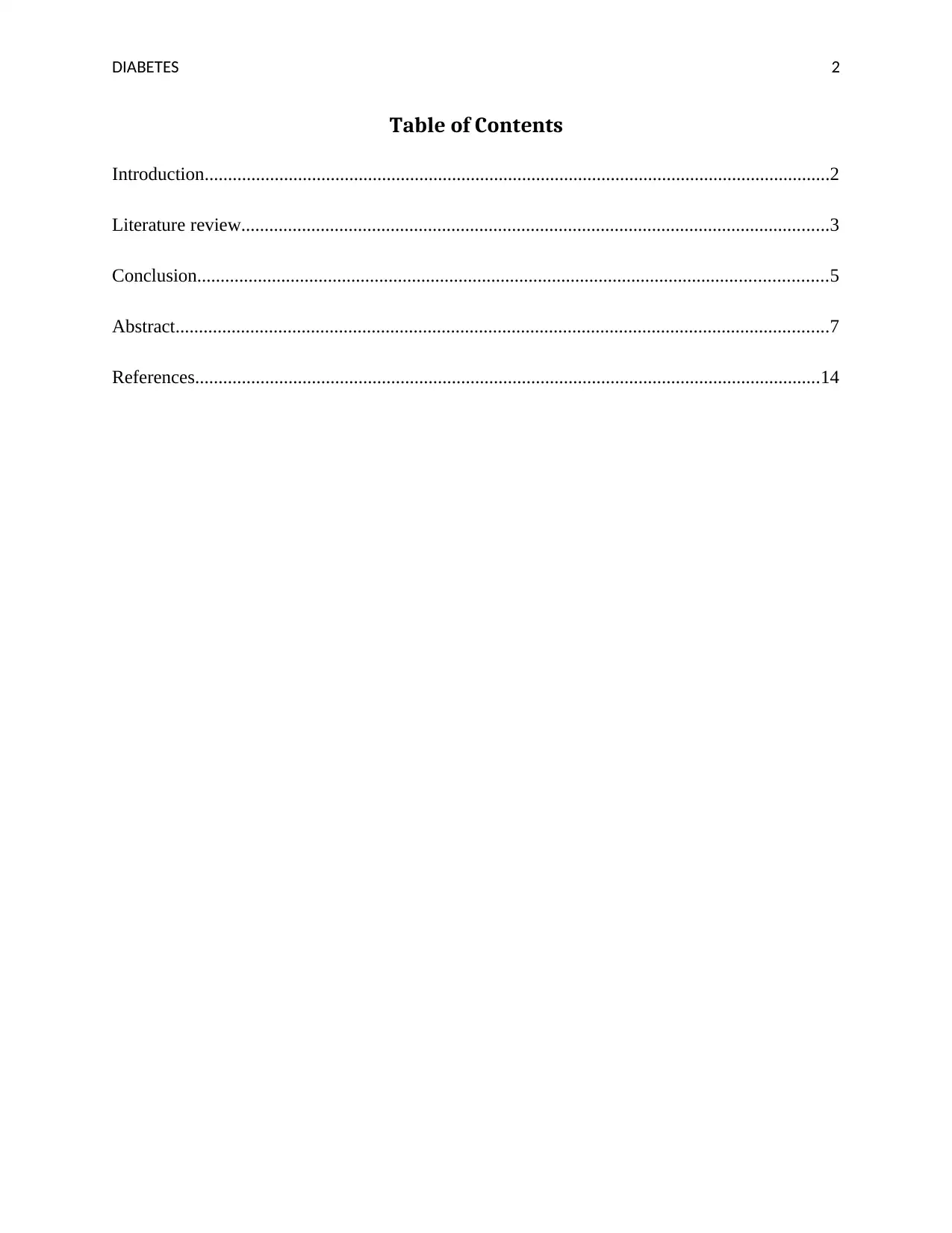
DIABETES 2
Table of Contents
Introduction......................................................................................................................................2
Literature review..............................................................................................................................3
Conclusion.......................................................................................................................................5
Abstract............................................................................................................................................7
References......................................................................................................................................14
Table of Contents
Introduction......................................................................................................................................2
Literature review..............................................................................................................................3
Conclusion.......................................................................................................................................5
Abstract............................................................................................................................................7
References......................................................................................................................................14
⊘ This is a preview!⊘
Do you want full access?
Subscribe today to unlock all pages.

Trusted by 1+ million students worldwide
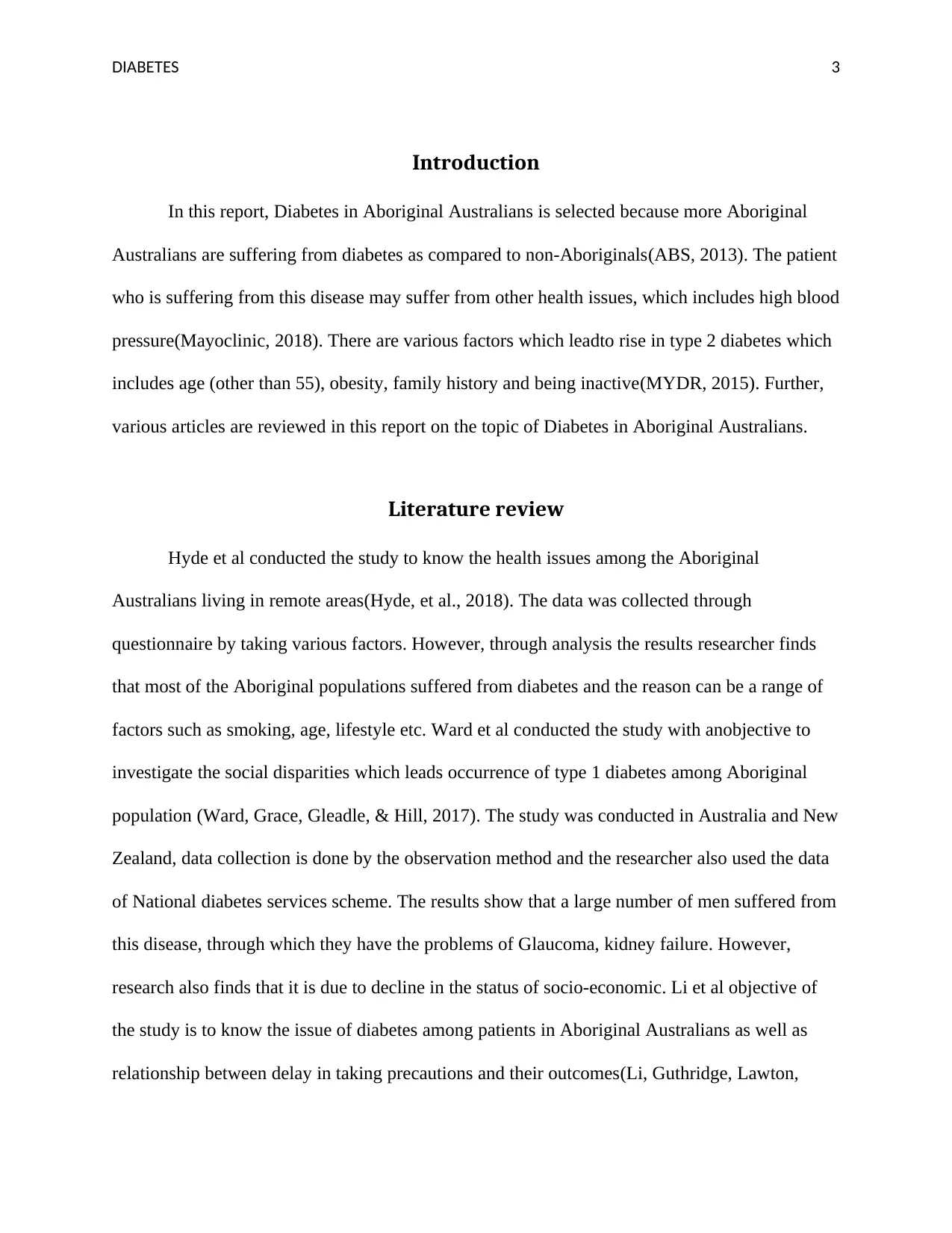
DIABETES 3
Introduction
In this report, Diabetes in Aboriginal Australians is selected because more Aboriginal
Australians are suffering from diabetes as compared to non-Aboriginals(ABS, 2013). The patient
who is suffering from this disease may suffer from other health issues, which includes high blood
pressure(Mayoclinic, 2018). There are various factors which leadto rise in type 2 diabetes which
includes age (other than 55), obesity, family history and being inactive(MYDR, 2015). Further,
various articles are reviewed in this report on the topic of Diabetes in Aboriginal Australians.
Literature review
Hyde et al conducted the study to know the health issues among the Aboriginal
Australians living in remote areas(Hyde, et al., 2018). The data was collected through
questionnaire by taking various factors. However, through analysis the results researcher finds
that most of the Aboriginal populations suffered from diabetes and the reason can be a range of
factors such as smoking, age, lifestyle etc. Ward et al conducted the study with anobjective to
investigate the social disparities which leads occurrence of type 1 diabetes among Aboriginal
population (Ward, Grace, Gleadle, & Hill, 2017). The study was conducted in Australia and New
Zealand, data collection is done by the observation method and the researcher also used the data
of National diabetes services scheme. The results show that a large number of men suffered from
this disease, through which they have the problems of Glaucoma, kidney failure. However,
research also finds that it is due to decline in the status of socio-economic. Li et al objective of
the study is to know the issue of diabetes among patients in Aboriginal Australians as well as
relationship between delay in taking precautions and their outcomes(Li, Guthridge, Lawton,
Introduction
In this report, Diabetes in Aboriginal Australians is selected because more Aboriginal
Australians are suffering from diabetes as compared to non-Aboriginals(ABS, 2013). The patient
who is suffering from this disease may suffer from other health issues, which includes high blood
pressure(Mayoclinic, 2018). There are various factors which leadto rise in type 2 diabetes which
includes age (other than 55), obesity, family history and being inactive(MYDR, 2015). Further,
various articles are reviewed in this report on the topic of Diabetes in Aboriginal Australians.
Literature review
Hyde et al conducted the study to know the health issues among the Aboriginal
Australians living in remote areas(Hyde, et al., 2018). The data was collected through
questionnaire by taking various factors. However, through analysis the results researcher finds
that most of the Aboriginal populations suffered from diabetes and the reason can be a range of
factors such as smoking, age, lifestyle etc. Ward et al conducted the study with anobjective to
investigate the social disparities which leads occurrence of type 1 diabetes among Aboriginal
population (Ward, Grace, Gleadle, & Hill, 2017). The study was conducted in Australia and New
Zealand, data collection is done by the observation method and the researcher also used the data
of National diabetes services scheme. The results show that a large number of men suffered from
this disease, through which they have the problems of Glaucoma, kidney failure. However,
research also finds that it is due to decline in the status of socio-economic. Li et al objective of
the study is to know the issue of diabetes among patients in Aboriginal Australians as well as
relationship between delay in taking precautions and their outcomes(Li, Guthridge, Lawton,
Paraphrase This Document
Need a fresh take? Get an instant paraphrase of this document with our AI Paraphraser
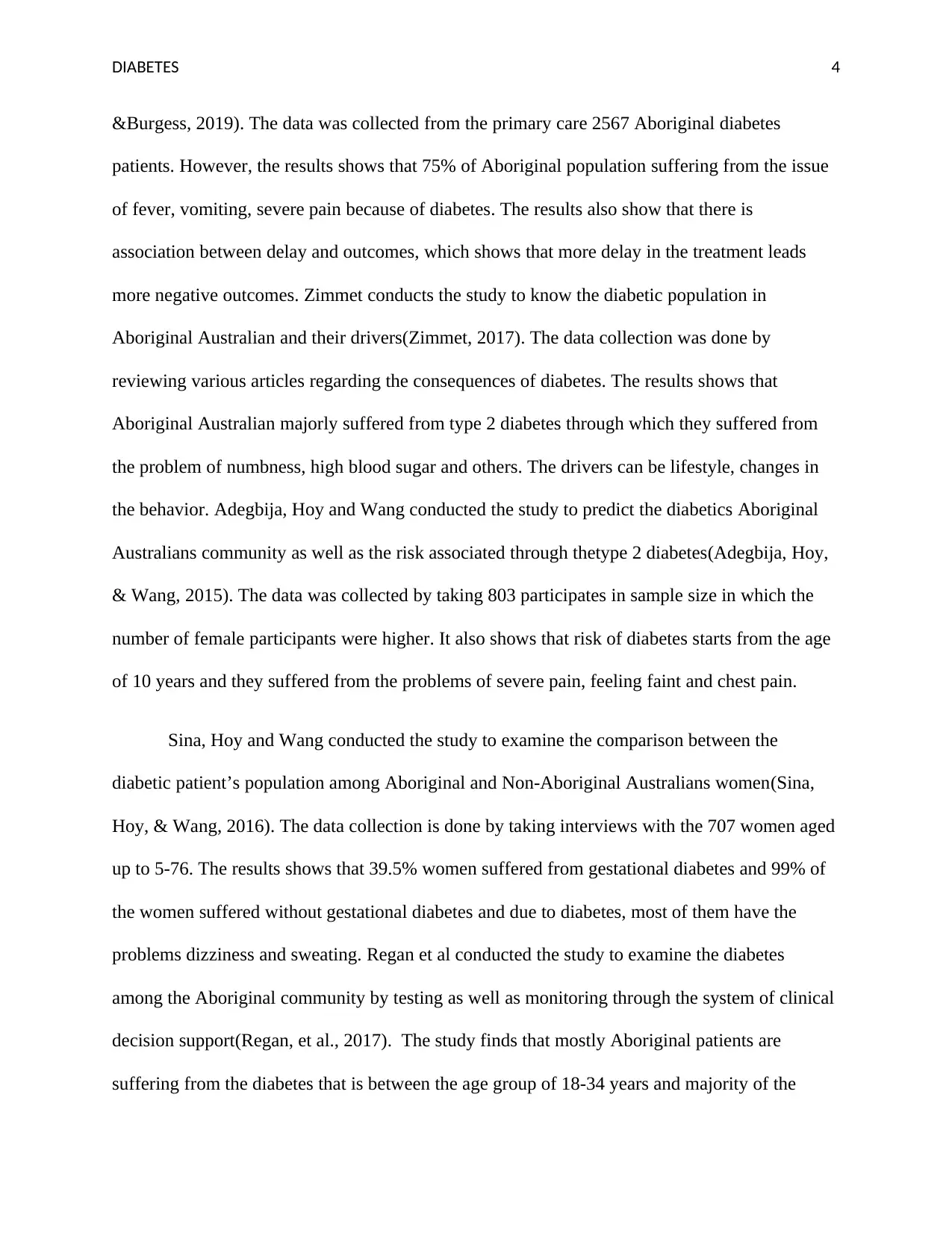
DIABETES 4
&Burgess, 2019). The data was collected from the primary care 2567 Aboriginal diabetes
patients. However, the results shows that 75% of Aboriginal population suffering from the issue
of fever, vomiting, severe pain because of diabetes. The results also show that there is
association between delay and outcomes, which shows that more delay in the treatment leads
more negative outcomes. Zimmet conducts the study to know the diabetic population in
Aboriginal Australian and their drivers(Zimmet, 2017). The data collection was done by
reviewing various articles regarding the consequences of diabetes. The results shows that
Aboriginal Australian majorly suffered from type 2 diabetes through which they suffered from
the problem of numbness, high blood sugar and others. The drivers can be lifestyle, changes in
the behavior. Adegbija, Hoy and Wang conducted the study to predict the diabetics Aboriginal
Australians community as well as the risk associated through thetype 2 diabetes(Adegbija, Hoy,
& Wang, 2015). The data was collected by taking 803 participates in sample size in which the
number of female participants were higher. It also shows that risk of diabetes starts from the age
of 10 years and they suffered from the problems of severe pain, feeling faint and chest pain.
Sina, Hoy and Wang conducted the study to examine the comparison between the
diabetic patient’s population among Aboriginal and Non-Aboriginal Australians women(Sina,
Hoy, & Wang, 2016). The data collection is done by taking interviews with the 707 women aged
up to 5-76. The results shows that 39.5% women suffered from gestational diabetes and 99% of
the women suffered without gestational diabetes and due to diabetes, most of them have the
problems dizziness and sweating. Regan et al conducted the study to examine the diabetes
among the Aboriginal community by testing as well as monitoring through the system of clinical
decision support(Regan, et al., 2017). The study finds that mostly Aboriginal patients are
suffering from the diabetes that is between the age group of 18-34 years and majority of the
&Burgess, 2019). The data was collected from the primary care 2567 Aboriginal diabetes
patients. However, the results shows that 75% of Aboriginal population suffering from the issue
of fever, vomiting, severe pain because of diabetes. The results also show that there is
association between delay and outcomes, which shows that more delay in the treatment leads
more negative outcomes. Zimmet conducts the study to know the diabetic population in
Aboriginal Australian and their drivers(Zimmet, 2017). The data collection was done by
reviewing various articles regarding the consequences of diabetes. The results shows that
Aboriginal Australian majorly suffered from type 2 diabetes through which they suffered from
the problem of numbness, high blood sugar and others. The drivers can be lifestyle, changes in
the behavior. Adegbija, Hoy and Wang conducted the study to predict the diabetics Aboriginal
Australians community as well as the risk associated through thetype 2 diabetes(Adegbija, Hoy,
& Wang, 2015). The data was collected by taking 803 participates in sample size in which the
number of female participants were higher. It also shows that risk of diabetes starts from the age
of 10 years and they suffered from the problems of severe pain, feeling faint and chest pain.
Sina, Hoy and Wang conducted the study to examine the comparison between the
diabetic patient’s population among Aboriginal and Non-Aboriginal Australians women(Sina,
Hoy, & Wang, 2016). The data collection is done by taking interviews with the 707 women aged
up to 5-76. The results shows that 39.5% women suffered from gestational diabetes and 99% of
the women suffered without gestational diabetes and due to diabetes, most of them have the
problems dizziness and sweating. Regan et al conducted the study to examine the diabetes
among the Aboriginal community by testing as well as monitoring through the system of clinical
decision support(Regan, et al., 2017). The study finds that mostly Aboriginal patients are
suffering from the diabetes that is between the age group of 18-34 years and majority of the
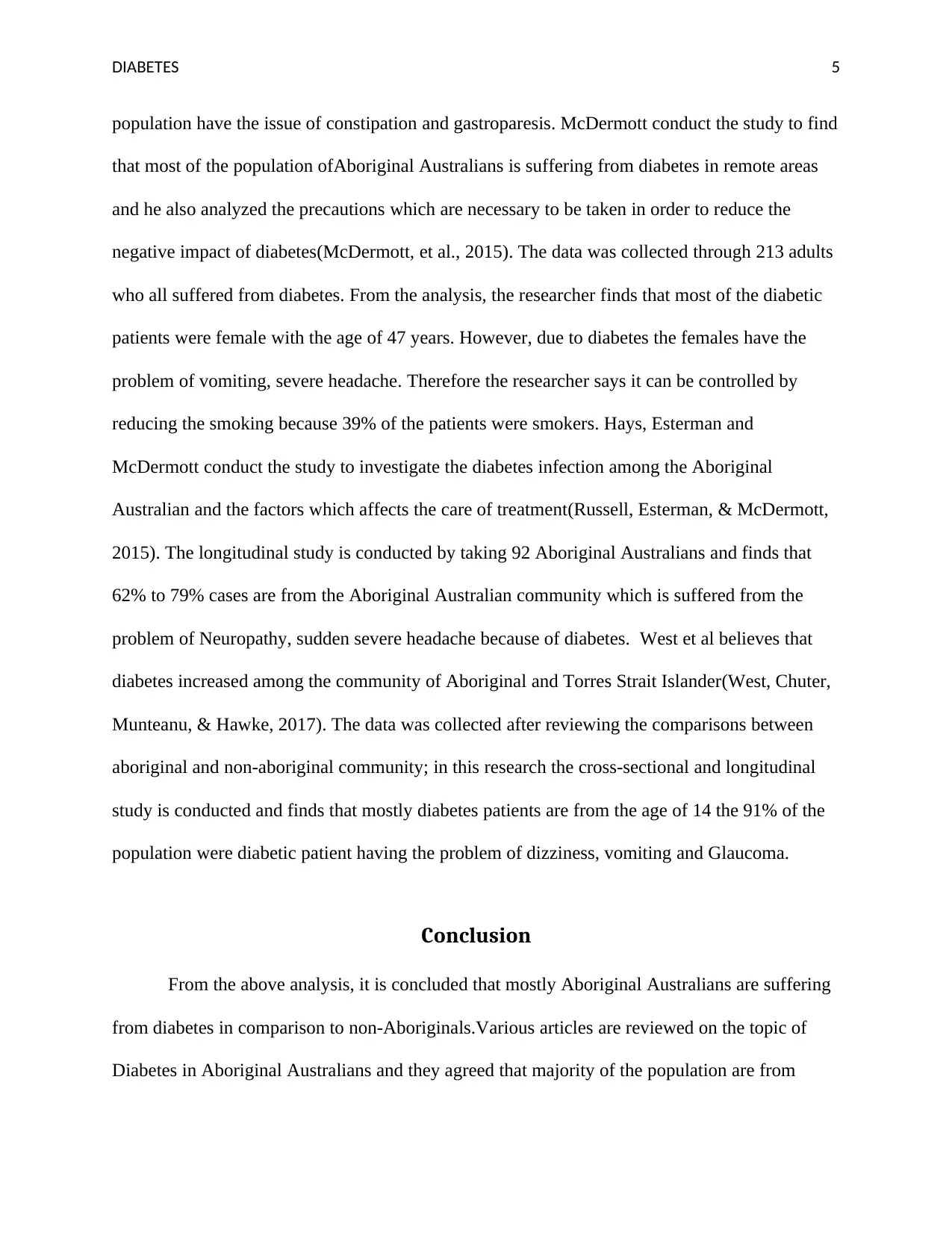
DIABETES 5
population have the issue of constipation and gastroparesis. McDermott conduct the study to find
that most of the population ofAboriginal Australians is suffering from diabetes in remote areas
and he also analyzed the precautions which are necessary to be taken in order to reduce the
negative impact of diabetes(McDermott, et al., 2015). The data was collected through 213 adults
who all suffered from diabetes. From the analysis, the researcher finds that most of the diabetic
patients were female with the age of 47 years. However, due to diabetes the females have the
problem of vomiting, severe headache. Therefore the researcher says it can be controlled by
reducing the smoking because 39% of the patients were smokers. Hays, Esterman and
McDermott conduct the study to investigate the diabetes infection among the Aboriginal
Australian and the factors which affects the care of treatment(Russell, Esterman, & McDermott,
2015). The longitudinal study is conducted by taking 92 Aboriginal Australians and finds that
62% to 79% cases are from the Aboriginal Australian community which is suffered from the
problem of Neuropathy, sudden severe headache because of diabetes. West et al believes that
diabetes increased among the community of Aboriginal and Torres Strait Islander(West, Chuter,
Munteanu, & Hawke, 2017). The data was collected after reviewing the comparisons between
aboriginal and non-aboriginal community; in this research the cross-sectional and longitudinal
study is conducted and finds that mostly diabetes patients are from the age of 14 the 91% of the
population were diabetic patient having the problem of dizziness, vomiting and Glaucoma.
Conclusion
From the above analysis, it is concluded that mostly Aboriginal Australians are suffering
from diabetes in comparison to non-Aboriginals.Various articles are reviewed on the topic of
Diabetes in Aboriginal Australians and they agreed that majority of the population are from
population have the issue of constipation and gastroparesis. McDermott conduct the study to find
that most of the population ofAboriginal Australians is suffering from diabetes in remote areas
and he also analyzed the precautions which are necessary to be taken in order to reduce the
negative impact of diabetes(McDermott, et al., 2015). The data was collected through 213 adults
who all suffered from diabetes. From the analysis, the researcher finds that most of the diabetic
patients were female with the age of 47 years. However, due to diabetes the females have the
problem of vomiting, severe headache. Therefore the researcher says it can be controlled by
reducing the smoking because 39% of the patients were smokers. Hays, Esterman and
McDermott conduct the study to investigate the diabetes infection among the Aboriginal
Australian and the factors which affects the care of treatment(Russell, Esterman, & McDermott,
2015). The longitudinal study is conducted by taking 92 Aboriginal Australians and finds that
62% to 79% cases are from the Aboriginal Australian community which is suffered from the
problem of Neuropathy, sudden severe headache because of diabetes. West et al believes that
diabetes increased among the community of Aboriginal and Torres Strait Islander(West, Chuter,
Munteanu, & Hawke, 2017). The data was collected after reviewing the comparisons between
aboriginal and non-aboriginal community; in this research the cross-sectional and longitudinal
study is conducted and finds that mostly diabetes patients are from the age of 14 the 91% of the
population were diabetic patient having the problem of dizziness, vomiting and Glaucoma.
Conclusion
From the above analysis, it is concluded that mostly Aboriginal Australians are suffering
from diabetes in comparison to non-Aboriginals.Various articles are reviewed on the topic of
Diabetes in Aboriginal Australians and they agreed that majority of the population are from
⊘ This is a preview!⊘
Do you want full access?
Subscribe today to unlock all pages.

Trusted by 1+ million students worldwide
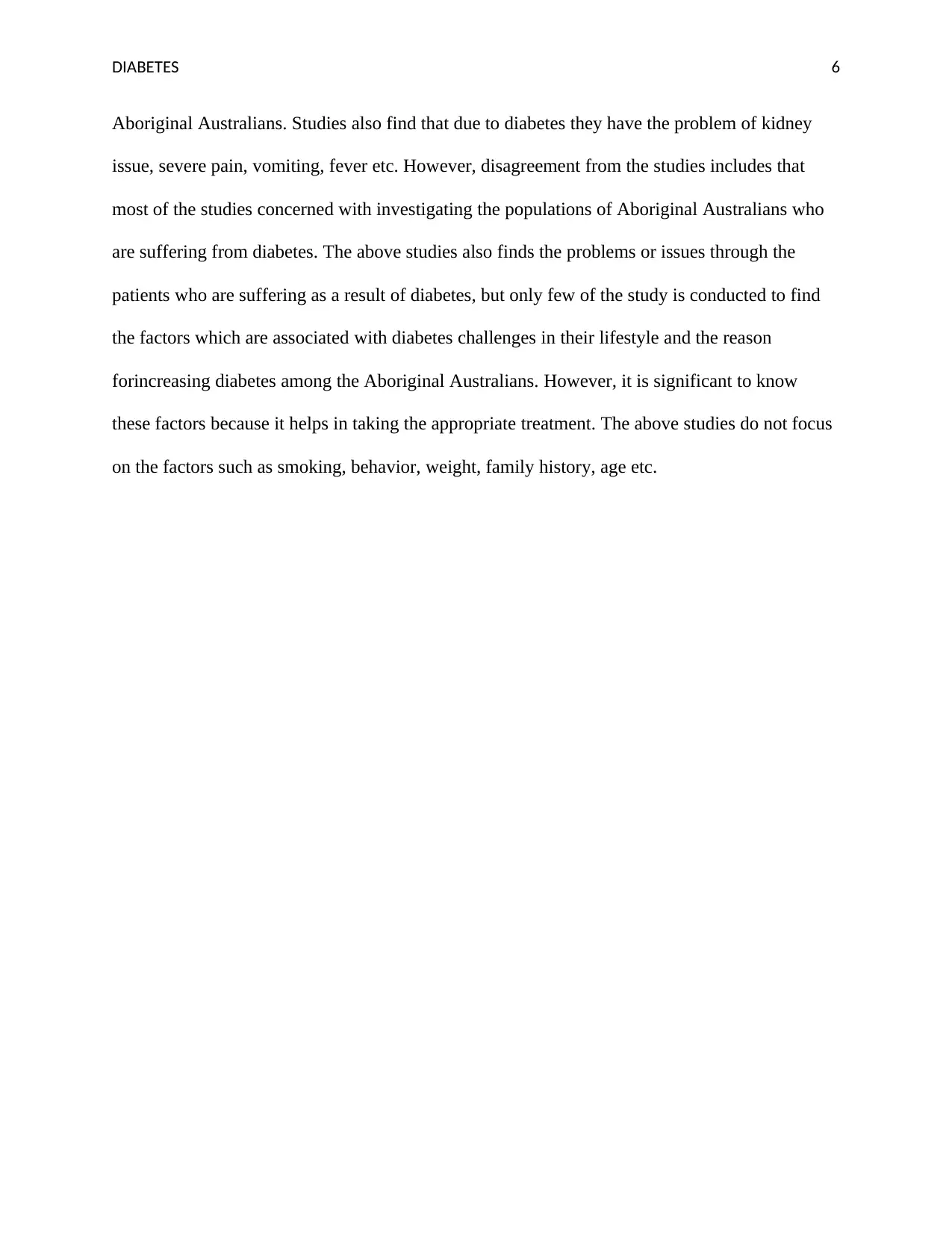
DIABETES 6
Aboriginal Australians. Studies also find that due to diabetes they have the problem of kidney
issue, severe pain, vomiting, fever etc. However, disagreement from the studies includes that
most of the studies concerned with investigating the populations of Aboriginal Australians who
are suffering from diabetes. The above studies also finds the problems or issues through the
patients who are suffering as a result of diabetes, but only few of the study is conducted to find
the factors which are associated with diabetes challenges in their lifestyle and the reason
forincreasing diabetes among the Aboriginal Australians. However, it is significant to know
these factors because it helps in taking the appropriate treatment. The above studies do not focus
on the factors such as smoking, behavior, weight, family history, age etc.
Aboriginal Australians. Studies also find that due to diabetes they have the problem of kidney
issue, severe pain, vomiting, fever etc. However, disagreement from the studies includes that
most of the studies concerned with investigating the populations of Aboriginal Australians who
are suffering from diabetes. The above studies also finds the problems or issues through the
patients who are suffering as a result of diabetes, but only few of the study is conducted to find
the factors which are associated with diabetes challenges in their lifestyle and the reason
forincreasing diabetes among the Aboriginal Australians. However, it is significant to know
these factors because it helps in taking the appropriate treatment. The above studies do not focus
on the factors such as smoking, behavior, weight, family history, age etc.
Paraphrase This Document
Need a fresh take? Get an instant paraphrase of this document with our AI Paraphraser
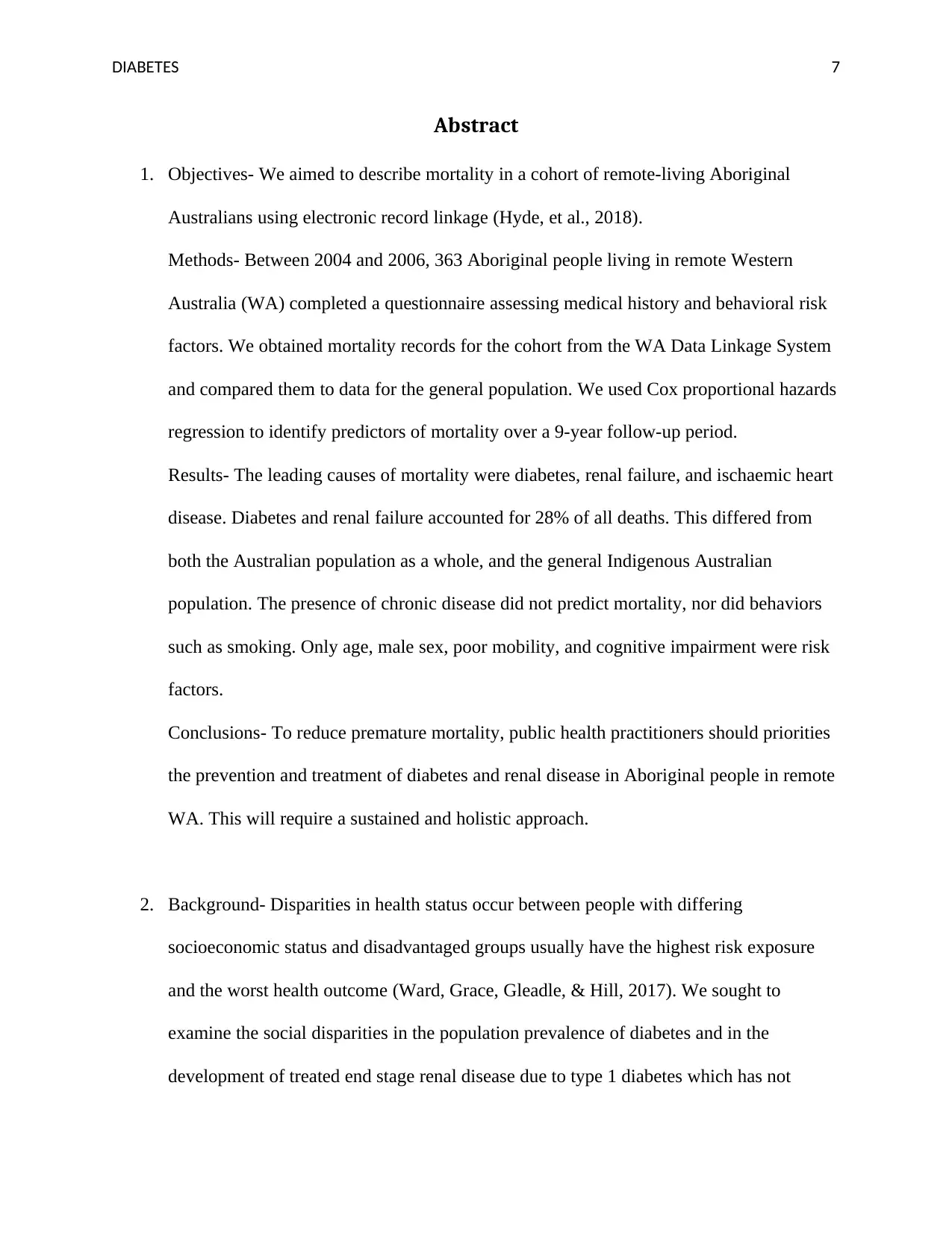
DIABETES 7
Abstract
1. Objectives- We aimed to describe mortality in a cohort of remote-living Aboriginal
Australians using electronic record linkage (Hyde, et al., 2018).
Methods- Between 2004 and 2006, 363 Aboriginal people living in remote Western
Australia (WA) completed a questionnaire assessing medical history and behavioral risk
factors. We obtained mortality records for the cohort from the WA Data Linkage System
and compared them to data for the general population. We used Cox proportional hazards
regression to identify predictors of mortality over a 9-year follow-up period.
Results- The leading causes of mortality were diabetes, renal failure, and ischaemic heart
disease. Diabetes and renal failure accounted for 28% of all deaths. This differed from
both the Australian population as a whole, and the general Indigenous Australian
population. The presence of chronic disease did not predict mortality, nor did behaviors
such as smoking. Only age, male sex, poor mobility, and cognitive impairment were risk
factors.
Conclusions- To reduce premature mortality, public health practitioners should priorities
the prevention and treatment of diabetes and renal disease in Aboriginal people in remote
WA. This will require a sustained and holistic approach.
2. Background- Disparities in health status occur between people with differing
socioeconomic status and disadvantaged groups usually have the highest risk exposure
and the worst health outcome (Ward, Grace, Gleadle, & Hill, 2017). We sought to
examine the social disparities in the population prevalence of diabetes and in the
development of treated end stage renal disease due to type 1 diabetes which has not
Abstract
1. Objectives- We aimed to describe mortality in a cohort of remote-living Aboriginal
Australians using electronic record linkage (Hyde, et al., 2018).
Methods- Between 2004 and 2006, 363 Aboriginal people living in remote Western
Australia (WA) completed a questionnaire assessing medical history and behavioral risk
factors. We obtained mortality records for the cohort from the WA Data Linkage System
and compared them to data for the general population. We used Cox proportional hazards
regression to identify predictors of mortality over a 9-year follow-up period.
Results- The leading causes of mortality were diabetes, renal failure, and ischaemic heart
disease. Diabetes and renal failure accounted for 28% of all deaths. This differed from
both the Australian population as a whole, and the general Indigenous Australian
population. The presence of chronic disease did not predict mortality, nor did behaviors
such as smoking. Only age, male sex, poor mobility, and cognitive impairment were risk
factors.
Conclusions- To reduce premature mortality, public health practitioners should priorities
the prevention and treatment of diabetes and renal disease in Aboriginal people in remote
WA. This will require a sustained and holistic approach.
2. Background- Disparities in health status occur between people with differing
socioeconomic status and disadvantaged groups usually have the highest risk exposure
and the worst health outcome (Ward, Grace, Gleadle, & Hill, 2017). We sought to
examine the social disparities in the population prevalence of diabetes and in the
development of treated end stage renal disease due to type 1 diabetes which has not
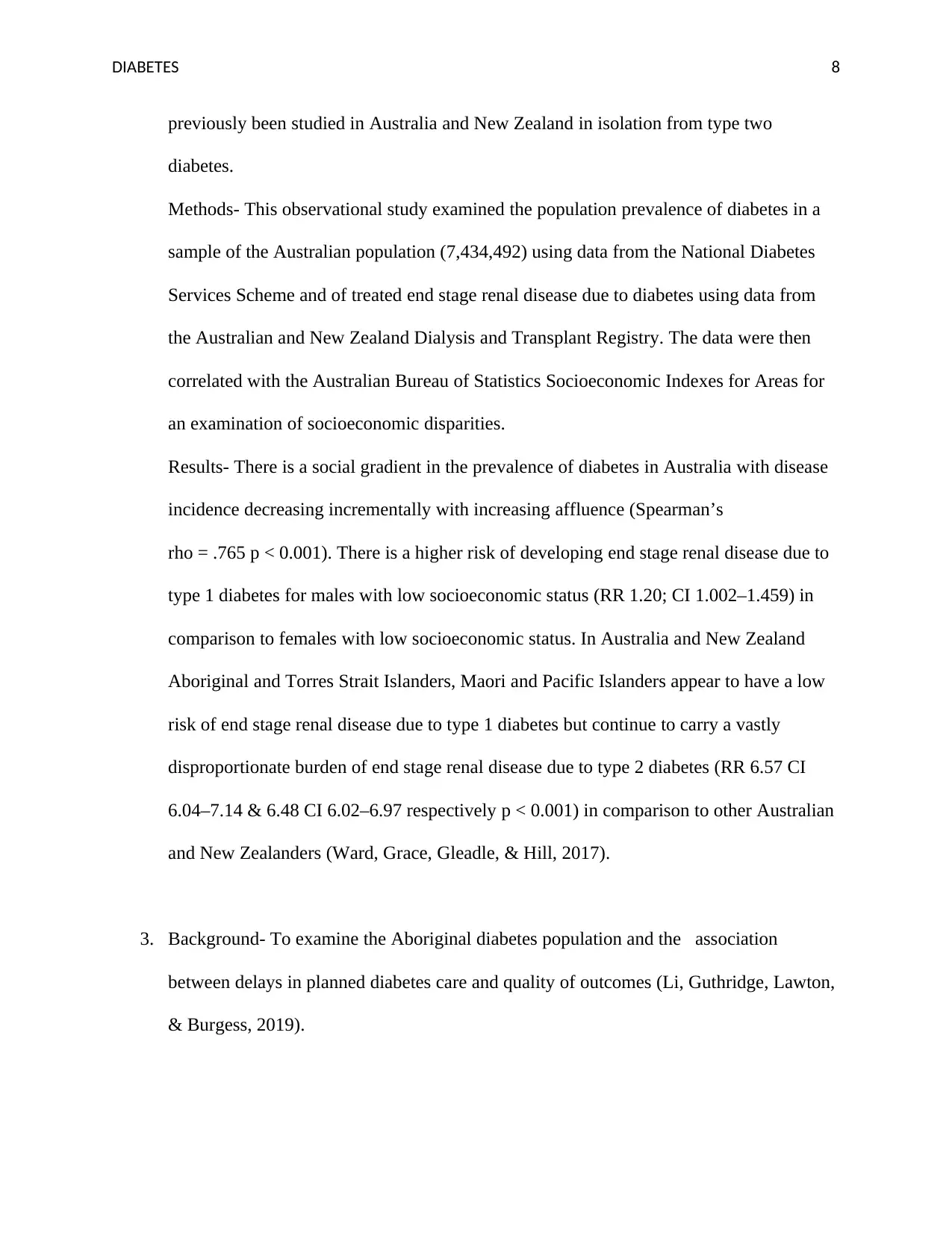
DIABETES 8
previously been studied in Australia and New Zealand in isolation from type two
diabetes.
Methods- This observational study examined the population prevalence of diabetes in a
sample of the Australian population (7,434,492) using data from the National Diabetes
Services Scheme and of treated end stage renal disease due to diabetes using data from
the Australian and New Zealand Dialysis and Transplant Registry. The data were then
correlated with the Australian Bureau of Statistics Socioeconomic Indexes for Areas for
an examination of socioeconomic disparities.
Results- There is a social gradient in the prevalence of diabetes in Australia with disease
incidence decreasing incrementally with increasing affluence (Spearman’s
rho = .765 p < 0.001). There is a higher risk of developing end stage renal disease due to
type 1 diabetes for males with low socioeconomic status (RR 1.20; CI 1.002–1.459) in
comparison to females with low socioeconomic status. In Australia and New Zealand
Aboriginal and Torres Strait Islanders, Maori and Pacific Islanders appear to have a low
risk of end stage renal disease due to type 1 diabetes but continue to carry a vastly
disproportionate burden of end stage renal disease due to type 2 diabetes (RR 6.57 CI
6.04–7.14 & 6.48 CI 6.02–6.97 respectively p < 0.001) in comparison to other Australian
and New Zealanders (Ward, Grace, Gleadle, & Hill, 2017).
3. Background- To examine the Aboriginal diabetes population and the association
between delays in planned diabetes care and quality of outcomes (Li, Guthridge, Lawton,
& Burgess, 2019).
previously been studied in Australia and New Zealand in isolation from type two
diabetes.
Methods- This observational study examined the population prevalence of diabetes in a
sample of the Australian population (7,434,492) using data from the National Diabetes
Services Scheme and of treated end stage renal disease due to diabetes using data from
the Australian and New Zealand Dialysis and Transplant Registry. The data were then
correlated with the Australian Bureau of Statistics Socioeconomic Indexes for Areas for
an examination of socioeconomic disparities.
Results- There is a social gradient in the prevalence of diabetes in Australia with disease
incidence decreasing incrementally with increasing affluence (Spearman’s
rho = .765 p < 0.001). There is a higher risk of developing end stage renal disease due to
type 1 diabetes for males with low socioeconomic status (RR 1.20; CI 1.002–1.459) in
comparison to females with low socioeconomic status. In Australia and New Zealand
Aboriginal and Torres Strait Islanders, Maori and Pacific Islanders appear to have a low
risk of end stage renal disease due to type 1 diabetes but continue to carry a vastly
disproportionate burden of end stage renal disease due to type 2 diabetes (RR 6.57 CI
6.04–7.14 & 6.48 CI 6.02–6.97 respectively p < 0.001) in comparison to other Australian
and New Zealanders (Ward, Grace, Gleadle, & Hill, 2017).
3. Background- To examine the Aboriginal diabetes population and the association
between delays in planned diabetes care and quality of outcomes (Li, Guthridge, Lawton,
& Burgess, 2019).
⊘ This is a preview!⊘
Do you want full access?
Subscribe today to unlock all pages.

Trusted by 1+ million students worldwide
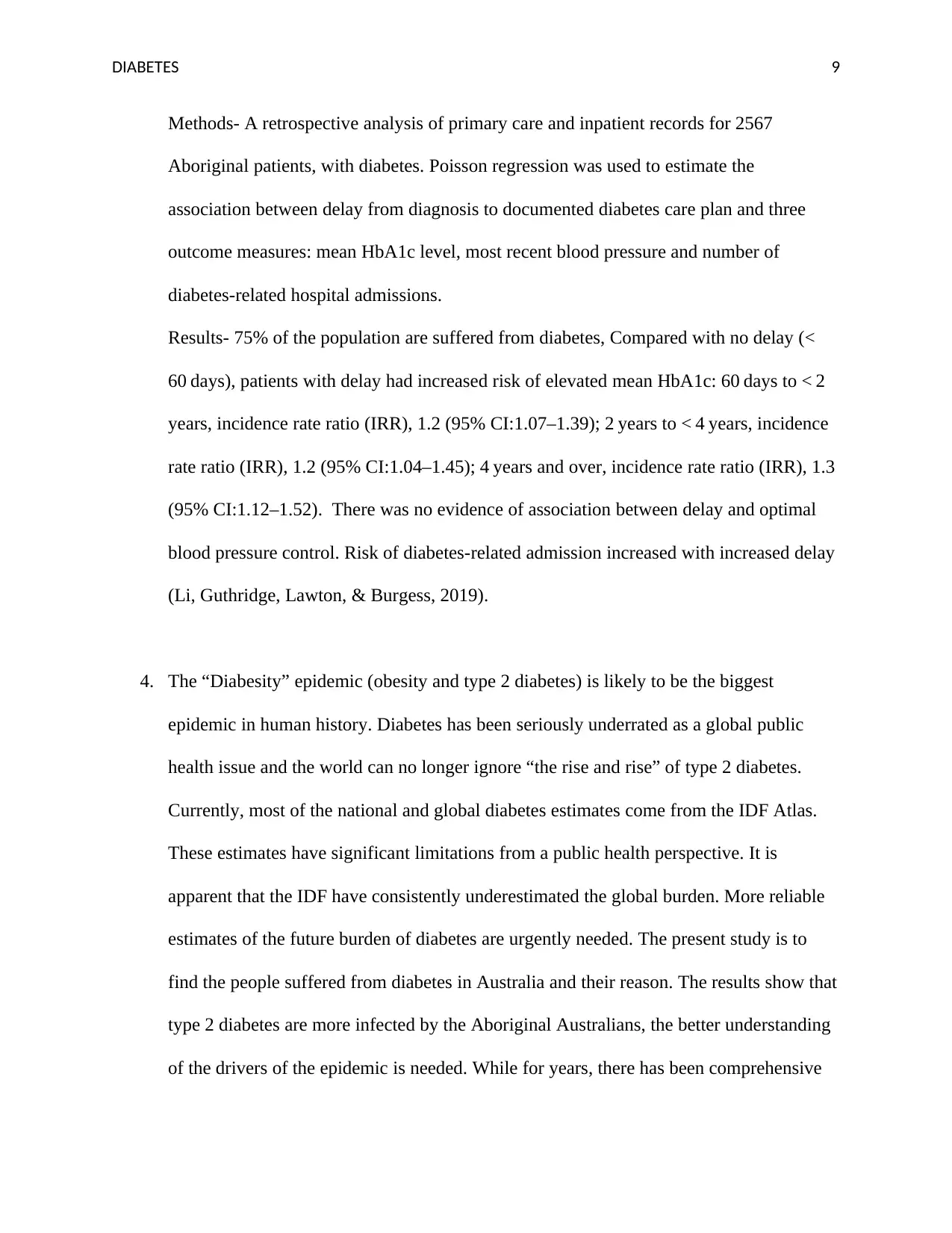
DIABETES 9
Methods- A retrospective analysis of primary care and inpatient records for 2567
Aboriginal patients, with diabetes. Poisson regression was used to estimate the
association between delay from diagnosis to documented diabetes care plan and three
outcome measures: mean HbA1c level, most recent blood pressure and number of
diabetes-related hospital admissions.
Results- 75% of the population are suffered from diabetes, Compared with no delay (<
60 days), patients with delay had increased risk of elevated mean HbA1c: 60 days to < 2
years, incidence rate ratio (IRR), 1.2 (95% CI:1.07–1.39); 2 years to < 4 years, incidence
rate ratio (IRR), 1.2 (95% CI:1.04–1.45); 4 years and over, incidence rate ratio (IRR), 1.3
(95% CI:1.12–1.52). There was no evidence of association between delay and optimal
blood pressure control. Risk of diabetes-related admission increased with increased delay
(Li, Guthridge, Lawton, & Burgess, 2019).
4. The “Diabesity” epidemic (obesity and type 2 diabetes) is likely to be the biggest
epidemic in human history. Diabetes has been seriously underrated as a global public
health issue and the world can no longer ignore “the rise and rise” of type 2 diabetes.
Currently, most of the national and global diabetes estimates come from the IDF Atlas.
These estimates have significant limitations from a public health perspective. It is
apparent that the IDF have consistently underestimated the global burden. More reliable
estimates of the future burden of diabetes are urgently needed. The present study is to
find the people suffered from diabetes in Australia and their reason. The results show that
type 2 diabetes are more infected by the Aboriginal Australians, the better understanding
of the drivers of the epidemic is needed. While for years, there has been comprehensive
Methods- A retrospective analysis of primary care and inpatient records for 2567
Aboriginal patients, with diabetes. Poisson regression was used to estimate the
association between delay from diagnosis to documented diabetes care plan and three
outcome measures: mean HbA1c level, most recent blood pressure and number of
diabetes-related hospital admissions.
Results- 75% of the population are suffered from diabetes, Compared with no delay (<
60 days), patients with delay had increased risk of elevated mean HbA1c: 60 days to < 2
years, incidence rate ratio (IRR), 1.2 (95% CI:1.07–1.39); 2 years to < 4 years, incidence
rate ratio (IRR), 1.2 (95% CI:1.04–1.45); 4 years and over, incidence rate ratio (IRR), 1.3
(95% CI:1.12–1.52). There was no evidence of association between delay and optimal
blood pressure control. Risk of diabetes-related admission increased with increased delay
(Li, Guthridge, Lawton, & Burgess, 2019).
4. The “Diabesity” epidemic (obesity and type 2 diabetes) is likely to be the biggest
epidemic in human history. Diabetes has been seriously underrated as a global public
health issue and the world can no longer ignore “the rise and rise” of type 2 diabetes.
Currently, most of the national and global diabetes estimates come from the IDF Atlas.
These estimates have significant limitations from a public health perspective. It is
apparent that the IDF have consistently underestimated the global burden. More reliable
estimates of the future burden of diabetes are urgently needed. The present study is to
find the people suffered from diabetes in Australia and their reason. The results show that
type 2 diabetes are more infected by the Aboriginal Australians, the better understanding
of the drivers of the epidemic is needed. While for years, there has been comprehensive
Paraphrase This Document
Need a fresh take? Get an instant paraphrase of this document with our AI Paraphraser
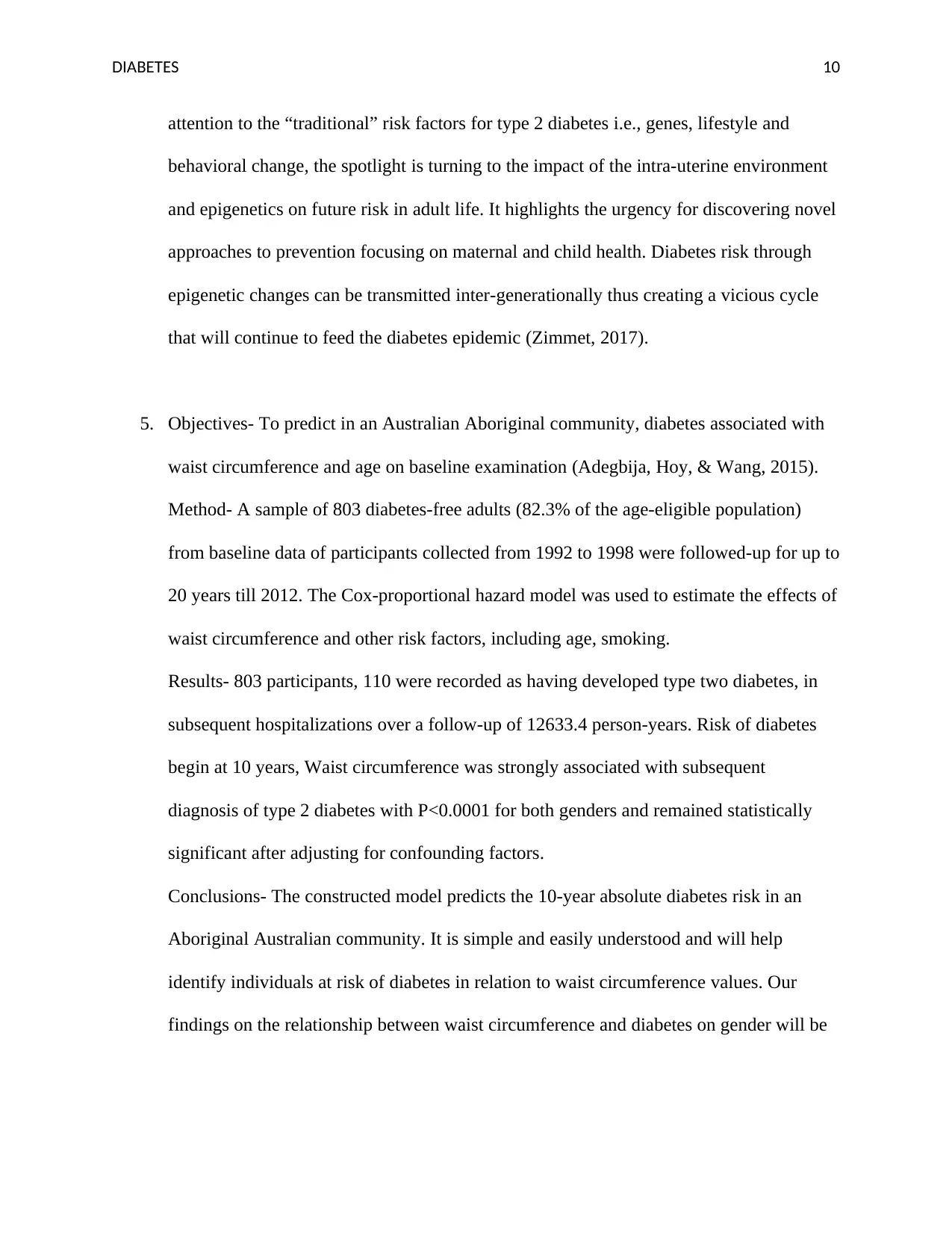
DIABETES 10
attention to the “traditional” risk factors for type 2 diabetes i.e., genes, lifestyle and
behavioral change, the spotlight is turning to the impact of the intra-uterine environment
and epigenetics on future risk in adult life. It highlights the urgency for discovering novel
approaches to prevention focusing on maternal and child health. Diabetes risk through
epigenetic changes can be transmitted inter-generationally thus creating a vicious cycle
that will continue to feed the diabetes epidemic (Zimmet, 2017).
5. Objectives- To predict in an Australian Aboriginal community, diabetes associated with
waist circumference and age on baseline examination (Adegbija, Hoy, & Wang, 2015).
Method- A sample of 803 diabetes-free adults (82.3% of the age-eligible population)
from baseline data of participants collected from 1992 to 1998 were followed-up for up to
20 years till 2012. The Cox-proportional hazard model was used to estimate the effects of
waist circumference and other risk factors, including age, smoking.
Results- 803 participants, 110 were recorded as having developed type two diabetes, in
subsequent hospitalizations over a follow-up of 12633.4 person-years. Risk of diabetes
begin at 10 years, Waist circumference was strongly associated with subsequent
diagnosis of type 2 diabetes with P<0.0001 for both genders and remained statistically
significant after adjusting for confounding factors.
Conclusions- The constructed model predicts the 10-year absolute diabetes risk in an
Aboriginal Australian community. It is simple and easily understood and will help
identify individuals at risk of diabetes in relation to waist circumference values. Our
findings on the relationship between waist circumference and diabetes on gender will be
attention to the “traditional” risk factors for type 2 diabetes i.e., genes, lifestyle and
behavioral change, the spotlight is turning to the impact of the intra-uterine environment
and epigenetics on future risk in adult life. It highlights the urgency for discovering novel
approaches to prevention focusing on maternal and child health. Diabetes risk through
epigenetic changes can be transmitted inter-generationally thus creating a vicious cycle
that will continue to feed the diabetes epidemic (Zimmet, 2017).
5. Objectives- To predict in an Australian Aboriginal community, diabetes associated with
waist circumference and age on baseline examination (Adegbija, Hoy, & Wang, 2015).
Method- A sample of 803 diabetes-free adults (82.3% of the age-eligible population)
from baseline data of participants collected from 1992 to 1998 were followed-up for up to
20 years till 2012. The Cox-proportional hazard model was used to estimate the effects of
waist circumference and other risk factors, including age, smoking.
Results- 803 participants, 110 were recorded as having developed type two diabetes, in
subsequent hospitalizations over a follow-up of 12633.4 person-years. Risk of diabetes
begin at 10 years, Waist circumference was strongly associated with subsequent
diagnosis of type 2 diabetes with P<0.0001 for both genders and remained statistically
significant after adjusting for confounding factors.
Conclusions- The constructed model predicts the 10-year absolute diabetes risk in an
Aboriginal Australian community. It is simple and easily understood and will help
identify individuals at risk of diabetes in relation to waist circumference values. Our
findings on the relationship between waist circumference and diabetes on gender will be
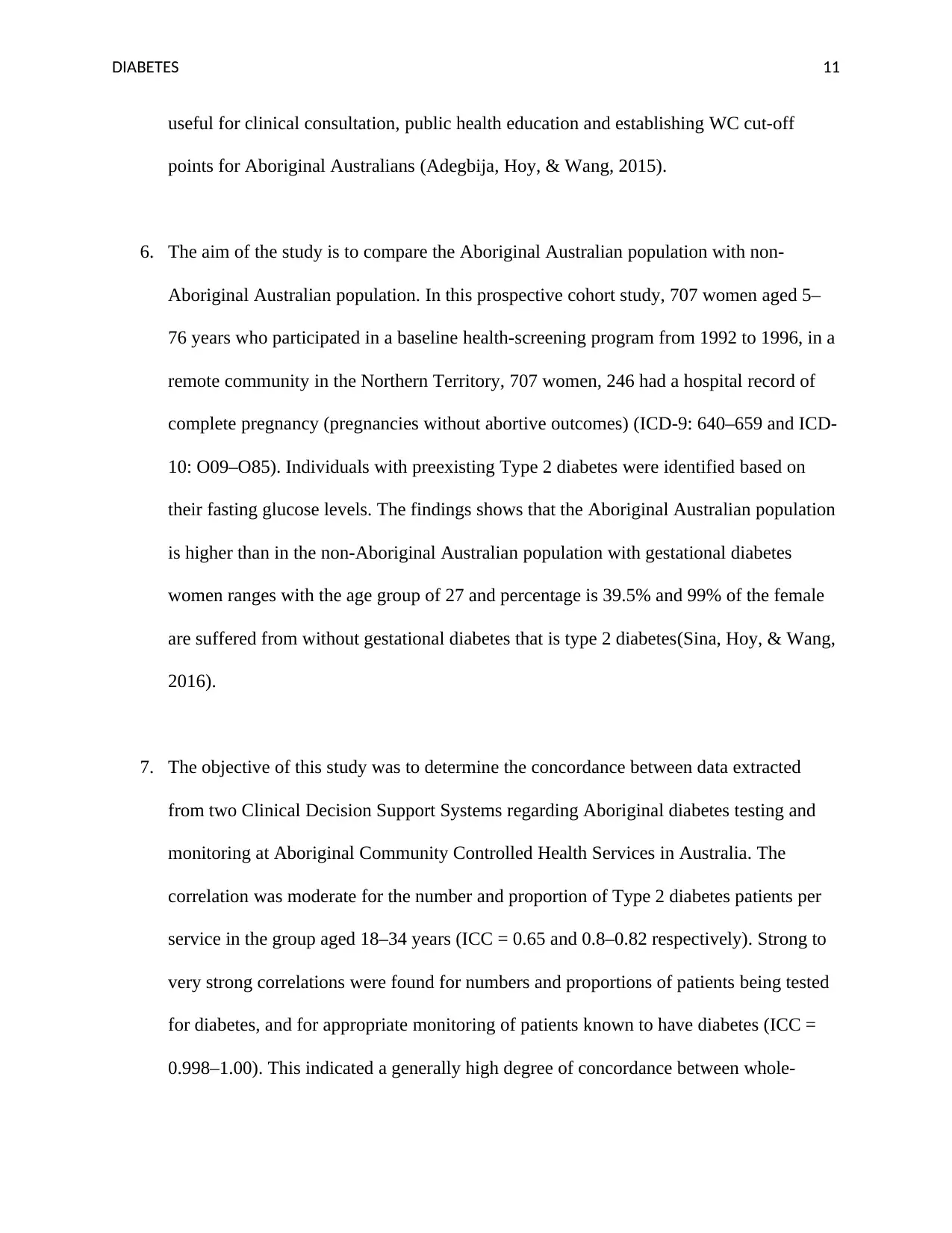
DIABETES 11
useful for clinical consultation, public health education and establishing WC cut-off
points for Aboriginal Australians (Adegbija, Hoy, & Wang, 2015).
6. The aim of the study is to compare the Aboriginal Australian population with non-
Aboriginal Australian population. In this prospective cohort study, 707 women aged 5–
76 years who participated in a baseline health-screening program from 1992 to 1996, in a
remote community in the Northern Territory, 707 women, 246 had a hospital record of
complete pregnancy (pregnancies without abortive outcomes) (ICD-9: 640–659 and ICD-
10: O09–O85). Individuals with preexisting Type 2 diabetes were identified based on
their fasting glucose levels. The findings shows that the Aboriginal Australian population
is higher than in the non-Aboriginal Australian population with gestational diabetes
women ranges with the age group of 27 and percentage is 39.5% and 99% of the female
are suffered from without gestational diabetes that is type 2 diabetes(Sina, Hoy, & Wang,
2016).
7. The objective of this study was to determine the concordance between data extracted
from two Clinical Decision Support Systems regarding Aboriginal diabetes testing and
monitoring at Aboriginal Community Controlled Health Services in Australia. The
correlation was moderate for the number and proportion of Type 2 diabetes patients per
service in the group aged 18–34 years (ICC = 0.65 and 0.8–0.82 respectively). Strong to
very strong correlations were found for numbers and proportions of patients being tested
for diabetes, and for appropriate monitoring of patients known to have diabetes (ICC =
0.998–1.00). This indicated a generally high degree of concordance between whole-
useful for clinical consultation, public health education and establishing WC cut-off
points for Aboriginal Australians (Adegbija, Hoy, & Wang, 2015).
6. The aim of the study is to compare the Aboriginal Australian population with non-
Aboriginal Australian population. In this prospective cohort study, 707 women aged 5–
76 years who participated in a baseline health-screening program from 1992 to 1996, in a
remote community in the Northern Territory, 707 women, 246 had a hospital record of
complete pregnancy (pregnancies without abortive outcomes) (ICD-9: 640–659 and ICD-
10: O09–O85). Individuals with preexisting Type 2 diabetes were identified based on
their fasting glucose levels. The findings shows that the Aboriginal Australian population
is higher than in the non-Aboriginal Australian population with gestational diabetes
women ranges with the age group of 27 and percentage is 39.5% and 99% of the female
are suffered from without gestational diabetes that is type 2 diabetes(Sina, Hoy, & Wang,
2016).
7. The objective of this study was to determine the concordance between data extracted
from two Clinical Decision Support Systems regarding Aboriginal diabetes testing and
monitoring at Aboriginal Community Controlled Health Services in Australia. The
correlation was moderate for the number and proportion of Type 2 diabetes patients per
service in the group aged 18–34 years (ICC = 0.65 and 0.8–0.82 respectively). Strong to
very strong correlations were found for numbers and proportions of patients being tested
for diabetes, and for appropriate monitoring of patients known to have diabetes (ICC =
0.998–1.00). This indicated a generally high degree of concordance between whole-
⊘ This is a preview!⊘
Do you want full access?
Subscribe today to unlock all pages.

Trusted by 1+ million students worldwide
1 out of 17
Related Documents
Your All-in-One AI-Powered Toolkit for Academic Success.
+13062052269
info@desklib.com
Available 24*7 on WhatsApp / Email
![[object Object]](/_next/static/media/star-bottom.7253800d.svg)
Unlock your academic potential
Copyright © 2020–2025 A2Z Services. All Rights Reserved. Developed and managed by ZUCOL.





